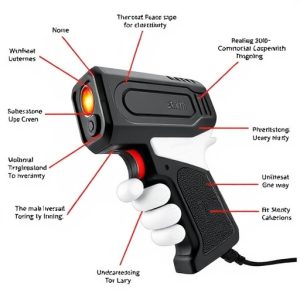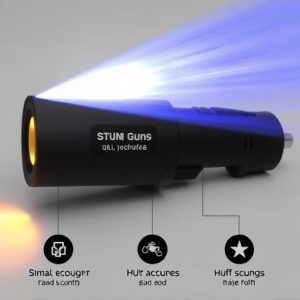Unveiling Stun Guns: Function, Varieties, and Legalities
Stun guns (electronic control devices, ECDs) temporarily disable targets via high-voltage, low-curre…….
Stun guns (electronic control devices, ECDs) temporarily disable targets via high-voltage, low-current pulses disrupting nervous system function, causing muscle contractions and paralysis. With varying intensities and features, they are used for self-defense, law enforcement, and security, prioritizing temporary incapacitation without permanent harm. Safe deployment requires understanding local laws, proper training, inspections, storage, and awareness of potential side effects like pain, spasms, or respiratory distress. Knowing how does a stun gun work involves grasping its electrical muscle disruption mechanism through nerve signal interference tailored to specific applications and user needs.
“Unveiling the power of electrical muscle disruption technology, this comprehensive guide explores the revolutionary concept behind stun guns. From understanding the science of their operation—how does a stun gun work?—to exploring diverse device types, we delve into the safety and legal aspects surrounding these powerful tools. Discover the evolving landscape of personal protection as we navigate the various applications and considerations of electrical muscle disruption devices.”
- Understanding the Technology Behind Stun Guns
- The Different Types of Electrical Muscle Disruption Devices
- Safety and Legal Considerations for Stun Gun Use
Understanding the Technology Behind Stun Guns
Stun guns, also known as electronic control devices (ECDs), are non-lethal weapons that use electrical muscle disruption to incapacitate a target. Understanding how they work is crucial for both users and those affected by their deployment. At its core, a stun gun generates high-voltage, low-current electrical pulses that disrupt the normal electrical signals in the body’s nervous system. This disruption causes muscles to contract uncontrollably, leading to temporary paralysis and pain.
The device delivers this pulse through two metal probes, typically located at the tip of the stun gun. When activated, the stun gun charges up and discharges the electrical pulse onto the target within a fraction of a second. The intensity of the shock can vary depending on the model and settings, but it’s designed to be enough to temporarily disable an individual without causing permanent harm. This makes them a popular choice for law enforcement, security personnel, and individuals seeking self-defense options.
The Different Types of Electrical Muscle Disruption Devices
Electrical muscle disruption devices, commonly known as stun guns, come in various types, each with unique features and applications. These non-lethal weapons use electrical current to disrupt muscular control, causing temporary incapacitation. The most common type is the hand-held stun gun, which fires two electrodes towards a target, delivering a strong electric shock. This design is popular for personal protection due to its ease of use and portability.
Another variant is the tactical stun gun, often used by law enforcement. These devices typically emit a more concentrated and powerful pulse, designed to disable without causing permanent harm. Some advanced models incorporate LED lighting or laser sights for better accuracy. The how does a stun gun work principle remains consistent across types—disrupting nerve signals to muscles—but the intensity and delivery methods differ, catering to specific user needs.
Safety and Legal Considerations for Stun Gun Use
When considering the use of electrical muscle disruption devices, such as stun guns, it’s imperative to address safety and legal aspects. Stun guns work by delivering a strong electric shock that disrupts the muscle control of a target, temporarily incapacitating them. However, this technology comes with potential risks and ethical concerns. Users must be aware of local laws regarding stun gun possession and use, as regulations vary widely from region to region.
Safety precautions are crucial for responsible stun gun ownership. Proper training in their use is essential to ensure users can deploy the device effectively while minimizing harm to themselves and others. Additionally, maintaining regular inspections and proper storage of stun guns can help prevent accidents. Users should also be aware of potential side effects, such as temporary pain, muscle spasms, or even respiratory distress in some cases, and understand when medical attention might be required after use.
Electrical Muscle Disruption Devices, including stun guns, have evolved as powerful tools for personal safety. By understanding the technology behind them, their diverse types, and crucial safety considerations, users can make informed decisions. Stun guns operate by delivering a strong electric shock, temporarily disabling muscles and rendering an assailant immobile. As these devices become more accessible, it’s essential to know their legal standing and use them responsibly to ensure safety for oneself and others.


